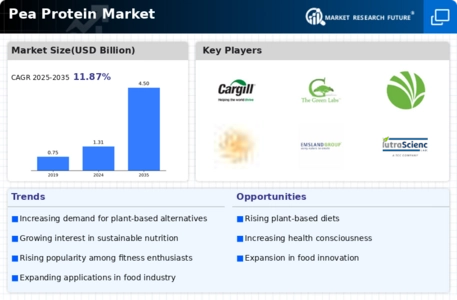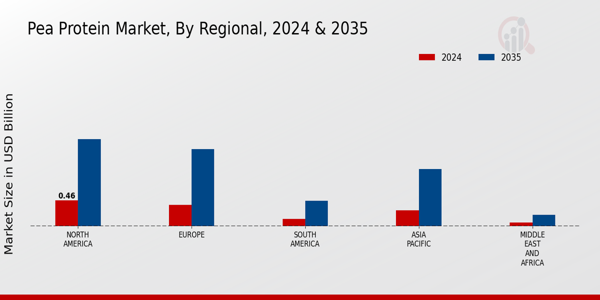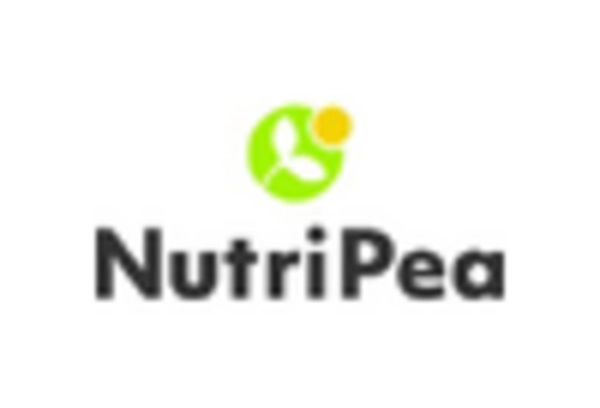Food Beverages
Nutritional Supplements
Animal Feed
Cosmetics
Pharmaceuticals
Isolates
Concentrates
Textured Pea Protein
Yellow Pea
Green Pea
Other Peas
Vegan Products
Gluten-Free Products
Meat Alternatives
North America
Europe
South America
Asia Pacific
Middle East and Africa
North America Outlook (USD Billion, 2019-2035)
North America Pea Protein Market by Application Type
Food Beverages
Nutritional Supplements
Animal Feed
Cosmetics
Pharmaceuticals
North America Pea Protein Market by Form Type
Isolates
Concentrates
Textured Pea Protein
North America Pea Protein Market by Source Type
Yellow Pea
Green Pea
Other Peas
North America Pea Protein Market by End Use Type
Vegan Products
Gluten-Free Products
Meat Alternatives
North America Pea Protein Market by Regional Type
US
Canada
US Outlook (USD Billion, 2019-2035)
US Pea Protein Market by Application Type
Food Beverages
Nutritional Supplements
Animal Feed
Cosmetics
Pharmaceuticals
US Pea Protein Market by Form Type
Isolates
Concentrates
Textured Pea Protein
US Pea Protein Market by Source Type
Yellow Pea
Green Pea
Other Peas
US Pea Protein Market by End Use Type
Vegan Products
Gluten-Free Products
Meat Alternatives
CANADA Outlook (USD Billion, 2019-2035)
CANADA Pea Protein Market by Application Type
Food Beverages
Nutritional Supplements
Animal Feed
Cosmetics
Pharmaceuticals
CANADA Pea Protein Market by Form Type
Isolates
Concentrates
Textured Pea Protein
CANADA Pea Protein Market by Source Type
Yellow Pea
Green Pea
Other Peas
CANADA Pea Protein Market by End Use Type
Vegan Products
Gluten-Free Products
Meat Alternatives
Europe Outlook (USD Billion, 2019-2035)
Europe Pea Protein Market by Application Type
Food Beverages
Nutritional Supplements
Animal Feed
Cosmetics
Pharmaceuticals
Europe Pea Protein Market by Form Type
Isolates
Concentrates
Textured Pea Protein
Europe Pea Protein Market by Source Type
Yellow Pea
Green Pea
Other Peas
Europe Pea Protein Market by End Use Type
Vegan Products
Gluten-Free Products
Meat Alternatives
Europe Pea Protein Market by Regional Type
Germany
UK
France
Russia
Italy
Spain
Rest of Europe
GERMANY Outlook (USD Billion, 2019-2035)
GERMANY Pea Protein Market by Application Type
Food Beverages
Nutritional Supplements
Animal Feed
Cosmetics
Pharmaceuticals
GERMANY Pea Protein Market by Form Type
Isolates
Concentrates
Textured Pea Protein
GERMANY Pea Protein Market by Source Type
Yellow Pea
Green Pea
Other Peas
GERMANY Pea Protein Market by End Use Type
Vegan Products
Gluten-Free Products
Meat Alternatives
UK Outlook (USD Billion, 2019-2035)
UK Pea Protein Market by Application Type
Food Beverages
Nutritional Supplements
Animal Feed
Cosmetics
Pharmaceuticals
UK Pea Protein Market by Form Type
Isolates
Concentrates
Textured Pea Protein
UK Pea Protein Market by Source Type
Yellow Pea
Green Pea
Other Peas
UK Pea Protein Market by End Use Type
Vegan Products
Gluten-Free Products
Meat Alternatives
FRANCE Outlook (USD Billion, 2019-2035)
FRANCE Pea Protein Market by Application Type
Food Beverages
Nutritional Supplements
Animal Feed
Cosmetics
Pharmaceuticals
FRANCE Pea Protein Market by Form Type
Isolates
Concentrates
Textured Pea Protein
FRANCE Pea Protein Market by Source Type
Yellow Pea
Green Pea
Other Peas
FRANCE Pea Protein Market by End Use Type
Vegan Products
Gluten-Free Products
Meat Alternatives
RUSSIA Outlook (USD Billion, 2019-2035)
RUSSIA Pea Protein Market by Application Type
Food Beverages
Nutritional Supplements
Animal Feed
Cosmetics
Pharmaceuticals
RUSSIA Pea Protein Market by Form Type
Isolates
Concentrates
Textured Pea Protein
RUSSIA Pea Protein Market by Source Type
Yellow Pea
Green Pea
Other Peas
RUSSIA Pea Protein Market by End Use Type
Vegan Products
Gluten-Free Products
Meat Alternatives
ITALY Outlook (USD Billion, 2019-2035)
ITALY Pea Protein Market by Application Type
Food Beverages
Nutritional Supplements
Animal Feed
Cosmetics
Pharmaceuticals
ITALY Pea Protein Market by Form Type
Isolates
Concentrates
Textured Pea Protein
ITALY Pea Protein Market by Source Type
Yellow Pea
Green Pea
Other Peas
ITALY Pea Protein Market by End Use Type
Vegan Products
Gluten-Free Products
Meat Alternatives
SPAIN Outlook (USD Billion, 2019-2035)
SPAIN Pea Protein Market by Application Type
Food Beverages
Nutritional Supplements
Animal Feed
Cosmetics
Pharmaceuticals
SPAIN Pea Protein Market by Form Type
Isolates
Concentrates
Textured Pea Protein
SPAIN Pea Protein Market by Source Type
Yellow Pea
Green Pea
Other Peas
SPAIN Pea Protein Market by End Use Type
Vegan Products
Gluten-Free Products
Meat Alternatives
REST OF EUROPE Outlook (USD Billion, 2019-2035)
REST OF EUROPE Pea Protein Market by Application Type
Food Beverages
Nutritional Supplements
Animal Feed
Cosmetics
Pharmaceuticals
REST OF EUROPE Pea Protein Market by Form Type
Isolates
Concentrates
Textured Pea Protein
REST OF EUROPE Pea Protein Market by Source Type
Yellow Pea
Green Pea
Other Peas
REST OF EUROPE Pea Protein Market by End Use Type
Vegan Products
Gluten-Free Products
Meat Alternatives
APAC Outlook (USD Billion, 2019-2035)
APAC Pea Protein Market by Application Type
Food Beverages
Nutritional Supplements
Animal Feed
Cosmetics
Pharmaceuticals
APAC Pea Protein Market by Form Type
Isolates
Concentrates
Textured Pea Protein
APAC Pea Protein Market by Source Type
Yellow Pea
Green Pea
Other Peas
APAC Pea Protein Market by End Use Type
Vegan Products
Gluten-Free Products
Meat Alternatives
APAC Pea Protein Market by Regional Type
China
India
Japan
South Korea
Malaysia
Thailand
Indonesia
Rest of APAC
CHINA Outlook (USD Billion, 2019-2035)
CHINA Pea Protein Market by Application Type
Food Beverages
Nutritional Supplements
Animal Feed
Cosmetics
Pharmaceuticals
CHINA Pea Protein Market by Form Type
Isolates
Concentrates
Textured Pea Protein
CHINA Pea Protein Market by Source Type
Yellow Pea
Green Pea
Other Peas
CHINA Pea Protein Market by End Use Type
Vegan Products
Gluten-Free Products
Meat Alternatives
INDIA Outlook (USD Billion, 2019-2035)
INDIA Pea Protein Market by Application Type
Food Beverages
Nutritional Supplements
Animal Feed
Cosmetics
Pharmaceuticals
INDIA Pea Protein Market by Form Type
Isolates
Concentrates
Textured Pea Protein
INDIA Pea Protein Market by Source Type
Yellow Pea
Green Pea
Other Peas
INDIA Pea Protein Market by End Use Type
Vegan Products
Gluten-Free Products
Meat Alternatives
JAPAN Outlook (USD Billion, 2019-2035)
JAPAN Pea Protein Market by Application Type
Food Beverages
Nutritional Supplements
Animal Feed
Cosmetics
Pharmaceuticals
JAPAN Pea Protein Market by Form Type
Isolates
Concentrates
Textured Pea Protein
JAPAN Pea Protein Market by Source Type
Yellow Pea
Green Pea
Other Peas
JAPAN Pea Protein Market by End Use Type
Vegan Products
Gluten-Free Products
Meat Alternatives
SOUTH KOREA Outlook (USD Billion, 2019-2035)
SOUTH KOREA Pea Protein Market by Application Type
Food Beverages
Nutritional Supplements
Animal Feed
Cosmetics
Pharmaceuticals
SOUTH KOREA Pea Protein Market by Form Type
Isolates
Concentrates
Textured Pea Protein
SOUTH KOREA Pea Protein Market by Source Type
Yellow Pea
Green Pea
Other Peas
SOUTH KOREA Pea Protein Market by End Use Type
Vegan Products
Gluten-Free Products
Meat Alternatives
MALAYSIA Outlook (USD Billion, 2019-2035)
MALAYSIA Pea Protein Market by Application Type
Food Beverages
Nutritional Supplements
Animal Feed
Cosmetics
Pharmaceuticals
MALAYSIA Pea Protein Market by Form Type
Isolates
Concentrates
Textured Pea Protein
MALAYSIA Pea Protein Market by Source Type
Yellow Pea
Green Pea
Other Peas
MALAYSIA Pea Protein Market by End Use Type
Vegan Products
Gluten-Free Products
Meat Alternatives
THAILAND Outlook (USD Billion, 2019-2035)
THAILAND Pea Protein Market by Application Type
Food Beverages
Nutritional Supplements
Animal Feed
Cosmetics
Pharmaceuticals
THAILAND Pea Protein Market by Form Type
Isolates
Concentrates
Textured Pea Protein
THAILAND Pea Protein Market by Source Type
Yellow Pea
Green Pea
Other Peas
THAILAND Pea Protein Market by End Use Type
Vegan Products
Gluten-Free Products
Meat Alternatives
INDONESIA Outlook (USD Billion, 2019-2035)
INDONESIA Pea Protein Market by Application Type
Food Beverages
Nutritional Supplements
Animal Feed
Cosmetics
Pharmaceuticals
INDONESIA Pea Protein Market by Form Type
Isolates
Concentrates
Textured Pea Protein
INDONESIA Pea Protein Market by Source Type
Yellow Pea
Green Pea
Other Peas
INDONESIA Pea Protein Market by End Use Type
Vegan Products
Gluten-Free Products
Meat Alternatives
REST OF APAC Outlook (USD Billion, 2019-2035)
REST OF APAC Pea Protein Market by Application Type
Food Beverages
Nutritional Supplements
Animal Feed
Cosmetics
Pharmaceuticals
REST OF APAC Pea Protein Market by Form Type
Isolates
Concentrates
Textured Pea Protein
REST OF APAC Pea Protein Market by Source Type
Yellow Pea
Green Pea
Other Peas
REST OF APAC Pea Protein Market by End Use Type
Vegan Products
Gluten-Free Products
Meat Alternatives
South America Outlook (USD Billion, 2019-2035)
South America Pea Protein Market by Application Type
Food Beverages
Nutritional Supplements
Animal Feed
Cosmetics
Pharmaceuticals
South America Pea Protein Market by Form Type
Isolates
Concentrates
Textured Pea Protein
South America Pea Protein Market by Source Type
Yellow Pea
Green Pea
Other Peas
South America Pea Protein Market by End Use Type
Vegan Products
Gluten-Free Products
Meat Alternatives
South America Pea Protein Market by Regional Type
Brazil
Mexico
Argentina
Rest of South America
BRAZIL Outlook (USD Billion, 2019-2035)
BRAZIL Pea Protein Market by Application Type
Food Beverages
Nutritional Supplements
Animal Feed
Cosmetics
Pharmaceuticals
BRAZIL Pea Protein Market by Form Type
Isolates
Concentrates
Textured Pea Protein
BRAZIL Pea Protein Market by Source Type
Yellow Pea
Green Pea
Other Peas
BRAZIL Pea Protein Market by End Use Type
Vegan Products
Gluten-Free Products
Meat Alternatives
MEXICO Outlook (USD Billion, 2019-2035)
MEXICO Pea Protein Market by Application Type
Food Beverages
Nutritional Supplements
Animal Feed
Cosmetics
Pharmaceuticals
MEXICO Pea Protein Market by Form Type
Isolates
Concentrates
Textured Pea Protein
MEXICO Pea Protein Market by Source Type
Yellow Pea
Green Pea
Other Peas
MEXICO Pea Protein Market by End Use Type
Vegan Products
Gluten-Free Products
Meat Alternatives
ARGENTINA Outlook (USD Billion, 2019-2035)
ARGENTINA Pea Protein Market by Application Type
Food Beverages
Nutritional Supplements
Animal Feed
Cosmetics
Pharmaceuticals
ARGENTINA Pea Protein Market by Form Type
Isolates
Concentrates
Textured Pea Protein
ARGENTINA Pea Protein Market by Source Type
Yellow Pea
Green Pea
Other Peas
ARGENTINA Pea Protein Market by End Use Type
Vegan Products
Gluten-Free Products
Meat Alternatives
REST OF SOUTH AMERICA Outlook (USD Billion, 2019-2035)
REST OF SOUTH AMERICA Pea Protein Market by Application Type
Food Beverages
Nutritional Supplements
Animal Feed
Cosmetics
Pharmaceuticals
REST OF SOUTH AMERICA Pea Protein Market by Form Type
Isolates
Concentrates
Textured Pea Protein
REST OF SOUTH AMERICA Pea Protein Market by Source Type
Yellow Pea
Green Pea
Other Peas
REST OF SOUTH AMERICA Pea Protein Market by End Use Type
Vegan Products
Gluten-Free Products
Meat Alternatives
MEA Outlook (USD Billion, 2019-2035)
MEA Pea Protein Market by Application Type
Food Beverages
Nutritional Supplements
Animal Feed
Cosmetics
Pharmaceuticals
MEA Pea Protein Market by Form Type
Isolates
Concentrates
Textured Pea Protein
MEA Pea Protein Market by Source Type
Yellow Pea
Green Pea
Other Peas
MEA Pea Protein Market by End Use Type
Vegan Products
Gluten-Free Products
Meat Alternatives
MEA Pea Protein Market by Regional Type
GCC Countries
South Africa
Rest of MEA
GCC COUNTRIES Outlook (USD Billion, 2019-2035)
GCC COUNTRIES Pea Protein Market by Application Type
Food Beverages
Nutritional Supplements
Animal Feed
Cosmetics
Pharmaceuticals
GCC COUNTRIES Pea Protein Market by Form Type
Isolates
Concentrates
Textured Pea Protein
GCC COUNTRIES Pea Protein Market by Source Type
Yellow Pea
Green Pea
Other Peas
GCC COUNTRIES Pea Protein Market by End Use Type
Vegan Products
Gluten-Free Products
Meat Alternatives
SOUTH AFRICA Outlook (USD Billion, 2019-2035)
SOUTH AFRICA Pea Protein Market by Application Type
Food Beverages
Nutritional Supplements
Animal Feed
Cosmetics
Pharmaceuticals
SOUTH AFRICA Pea Protein Market by Form Type
Isolates
Concentrates
Textured Pea Protein
SOUTH AFRICA Pea Protein Market by Source Type
Yellow Pea
Green Pea
Other Peas
SOUTH AFRICA Pea Protein Market by End Use Type
Vegan Products
Gluten-Free Products
Meat Alternatives
REST OF MEA Outlook (USD Billion, 2019-2035)
REST OF MEA Pea Protein Market by Application Type
Food Beverages
Nutritional Supplements
Animal Feed
Cosmetics
Pharmaceuticals
REST OF MEA Pea Protein Market by Form Type
Isolates
Concentrates
Textured Pea Protein
REST OF MEA Pea Protein Market by Source Type
Yellow Pea
Green Pea
Other Peas
REST OF MEA Pea Protein Market by End Use Type
Vegan Products
Gluten-Free Products
Meat Alternatives










Leave a Comment